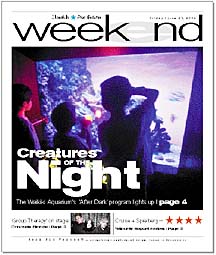


[ WEEKEND ]
DENNIS ODA / DODA@STAR-BULLETIN.COM
Flashlights are covered with a red filter so as not to disturb the fish at night.
Imagine going into your bedroom, getting a little too close to the dresser and ... Bam! You get swallowed up. Underwater action
Nocturnal fish hide by day and play at night
By Nancy Arcayna
narcayna@starbulletin.comFortunately, we do not have to worry about such problems. Sea creatures, on the other hand, do not have the same luxury. On the ocean floor, turkey fish can look like a rock -- just a part of the ocean furniture -- as opposed to a fearsome predator.
The Waikiki Aquarium's After Dark program discusses a range of behavioral patterns of a variety of diurnal and nocturnal reef creatures. And in the process, one even learns which members of the night shift are consuming the day shift. Look out for that night octopus!
As the lights go down in the aquarium, the action begins, we found during the After Dark program as we searched for sleeping fish and night predators, flashlights in hand. Flashlights were covered with red cellophane filters for a good reason.
"If the light startles the fish, they can run into the wall," said Mark Heckman, program director at the Waikiki Aquarium. In addition to getting bruised, "there are some fish that go into light shock and can actually die."
PRIOR TO THE tour, Heckman discussed night ecology. "The reef inhabitants work in shifts -- they are not all awake at the same time."
DENNIS ODA / DODA@STAR-BULLETIN.COM
Ryan Ariola, 8, use their flashlights to look at some of the information they were given during the informational lecture before the night "Flashlight" tour at the Waikiki Aquarium.
Too bad we are not like fishes, Heckman added. "If we wanted to make a little extra money, when we head off to school or work, we could rent our room out for the day."
Three-quarters of the animals in our waters are diurnal, or day creatures. These critters need to be alert in the day to gather their resources, avoid being eaten and reproduce. At night, shelter is found by hiding in the reef.
The fishes' needs determine when they roam. Many animals rely on vision and light to eat, either to find small specks of food and seaweed or to avoid eating toxins. "Otherwise, it would be like closing your eyes, reaching in your fridge, grabbing onto something and just taking a big bite."
Night fishes tend to have tentacles and antennae that prevent them from smacking into things as they move along.
Wrasses are the first to turn in and the last to get up in the morning, according to Heckman. "I'm sure you know people like this," he said with a chuckle. Wrasses bury themselves in the sand so they are rarely visible. "Occasionally, one doesn't get fully buried. It's kind of like a cat with its tail sticking out when it's trying to hide," Heckman said. The wrasse's eyes stop moving, though, indicating the fish's brain has shut down.
Puffer fish have scales on their bellies that resemble Velcro. "If you shine your lights on them too long, they will move and Velcro themselves on another part of the reef," Heckman said.
Where: Waikiki Aquarium Aquarium After Dark
When: 7 to 9 p.m. June 28, Aug. 10, Aug. 16 and Sept. 6
Admission: $8 adults; $7 children. Recommended for children 5 and up.
Call: 923-9741
And we are not the only commuters on the island, according to Heckman. A number of day fish feed in one area and rest someplace else.
ALTHOUGH THE After Dark program is popular with families, a few single adults often show up. Faye Pashos of Texas was visiting Hawaii with her parents, who are from Kentucky.
"We saw the class listed on the Internet," she said. "We're glad we came. The tour was just fascinating."
Rachel Ariola attends many of the aquarium's classes with her two sons, ages 8 and 5. "We are always coming to classes, but they are all different. I love watching the kids. The classes are structured in a way where you can actually see the growth. They can learn so much."
Heckman assured the group that humans are not necessarily at the top of sea predators' food list. Black tip reef sharks, he said, are like small poodles that wouldn't harm a flea.
"A hundred-pound jack may swim right next to you," he said. "It doesn't necessarily want to eat you; they just figure you are another big animal that may scare up a meal."
Other summer aquarium programs:
>> Exploring the Reef by Day: Explore Hawaii's shoreline, reef flat and tide pool habitats. Topics include marine life natural history, reef walking, and safety and conservation; 7:30-10 a.m. July 7 and 21. Costs $8 for adults, $7 children.>> Waikiki Aquarium Aquanauts: Weeklong biology class for children ages 8 to 18. The program features both in-the-water and in-the-lab experiences. Students need to be good swimmers and snorkelers. Sessions are held at the aquarium and at the education facility in Hanauma Bay. Takes place 8 a.m.-noon July 8-12; costs $250 per child. Aquanaut graduates can engage in a weeklong extension in which students conduct research, reading and writing to answer marine-life questions for the public.
>> Coral Spawning and Reef Romance: Class includes a slide lecture and a tour of the coral exhibits, 7-10 p.m. July 12. Participants must be at least 16. Costs $16.
>> Shark Overnight: Participants study shark biology, form and function and even construct a shark model. For families and children 5 and older. Youngsters must be accompanied by an adult. Costs $30 adults, $25 children.
Click for online
calendars and events.